Dream Gallery, Pakenham
Hana Earles & Anabel Robinson
27.11.23 - 07.12.23
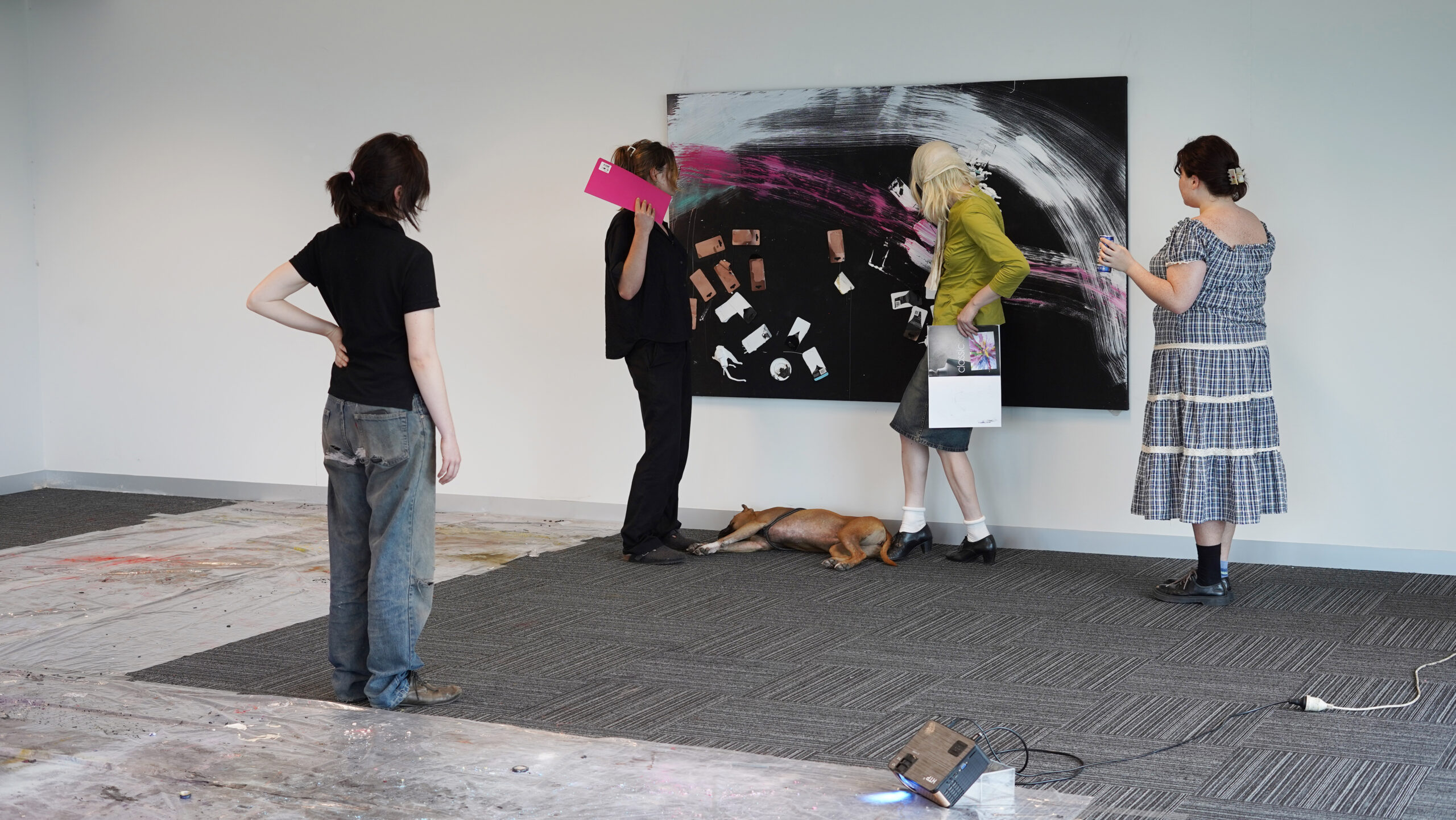
So I’m in Pakenham, in the middle of an empty office-turned-studio, in the middle of a field, perhaps too caffeinated, and staring at some art. Audrey chaperoned the four of us up from the city in her Subaru Forester accompanied by her dog, Ruby. The office-studio is extended from a warehouse that manufactures napkins. Hana refers to it as “the napkin factory” and I recall the live noise-set she performed a week prior that was under the moniker Napkin. I didn’t ask her if her stage name was based-on-factory because it likely was. The napkin factory operates in a building owned by Anabels father, which is how she ended up an hour out of the city in the first place. Lodged in a vacuous nothing; dispossessed from both country and the suburban trap, Pakenham, an area once known to farmers, has now been throttled into concrete and construction. I used to come out this way often, but for personal reasons I now endeavour to avoid the south-east.
No one has much to say once we’re in the office, contrast to the caffeine-induced gossip that subsumed majority of the car ride there. Being in a carpeted vortex, surrounded by a dormant neutrality that extends towards a succulent garden feels like an altar; a place of respect, that is, inhabited by silently standing around the artwork of your peers. As if just being in attendance with someone's work for a lengthy duration carries more weight than saying something. It is not common to be surprised by the artistic endeavours of a peer, as you can’t avoid looking into things too intimately or ask questions too domestically; where most decisions are accepted as mere tokens or trials in experimentation. Looking at an object, totally reliant on the natural progressions of assemblage and my prefixed trust of the artist's personal taste; I have no choice but to passively accept their motives.
I try my best to hold the belief that if I don’t entirely understand the decisions made behind a work of art, then the work must be doing something. I guess that’s admiration or a willingness to be allured. As it is important for your peers to attend artistic presentation. An endearing space where the artist must medley an objectivity towards themselves in front of an audience that perhaps understands them from different interjections. The work must be succinct, even if its viewers are a group of close friends. We are all artists, and we take ourselves seriously. But how does art change and evolve in these social conduits, how can it adapt and what are the referential boundaries that reinforce artistic credibility? The exposé of the internet appears to eliminate most of these dilemmas. Albeit, that in a null space like this, with artists who I wouldn't typically regard as everyday exhibitionists, I begin to question how necessary privacy, secrecy, agency and humility are to the sustainability of artistic presentation.
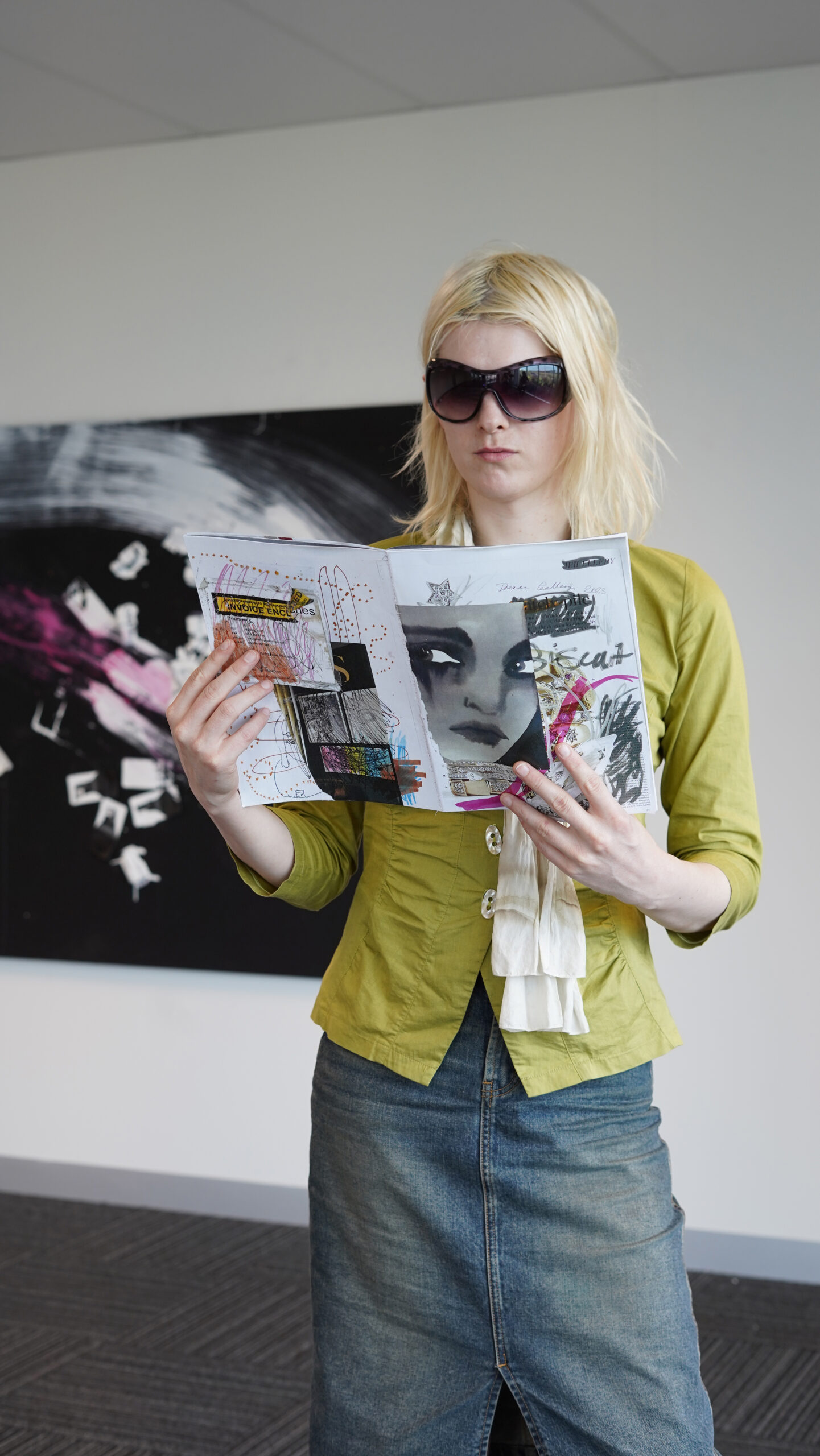
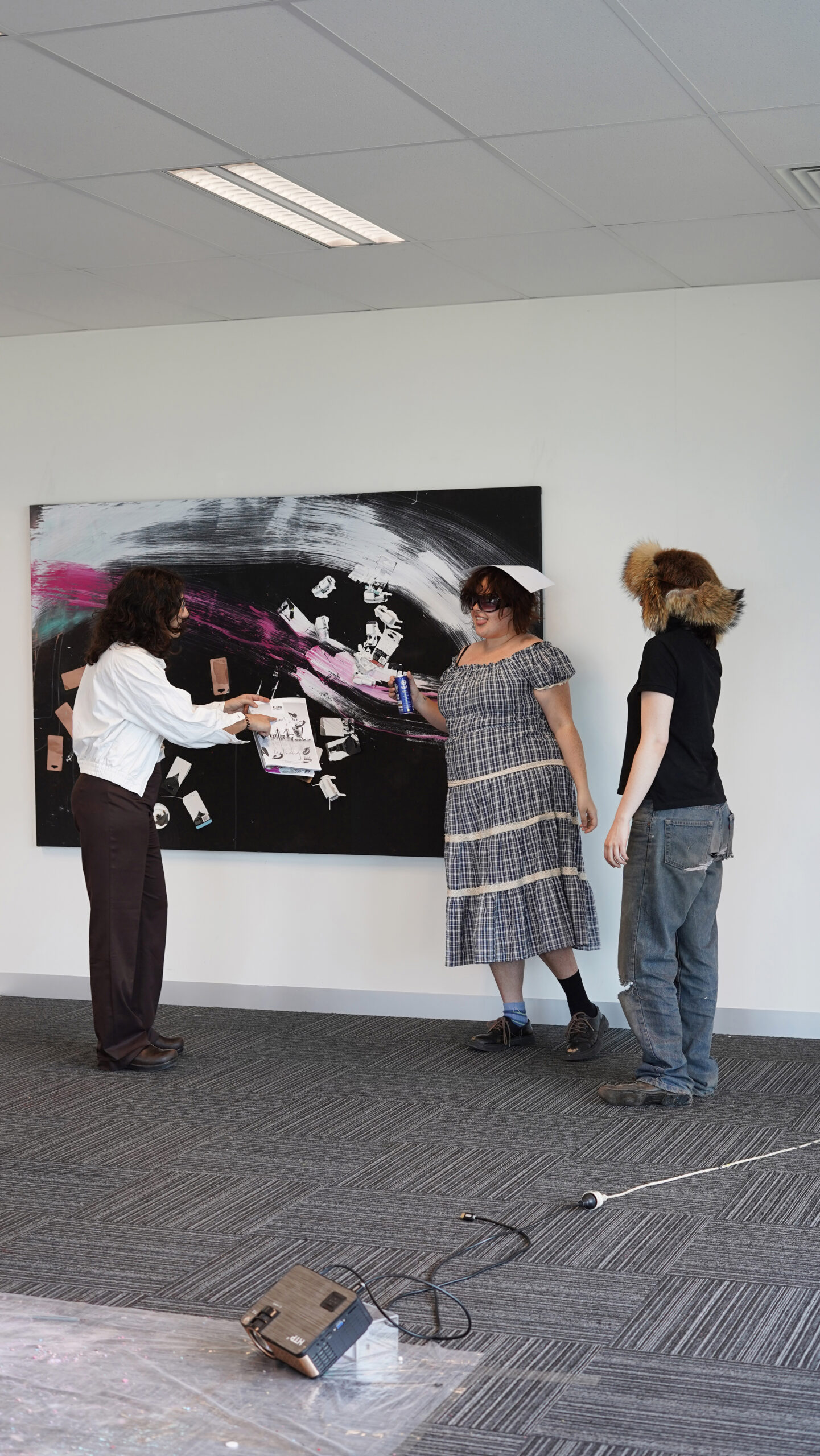
C: So to intro yourselves as people with brains and a personality, how would you describe your individual style?
A: Homeless lesbian nepo sherlock holmes.
H: Cute and helpless.
C: Biddy Mahy also infers to this feeling of secrecy in the exhibition text, is privacy important to your working processes?
H: I try to be private.
B: Yeah I prefer to work privately before I show work.
C: What are your everyday influences?
H: Contemporary art.
A: People in the city, art in McDonalds, songs on the radio, public art, advertising, work colleagues, buskers, magazines, screenshots in my camera roll, new buildings, Christmas decorations, dreams, vagrants.
C: The exhibition feels so innately girly, yet not lodged in adolescence at all. What were your teen addictions?
A: Straightening my hair and drinking. The brand sass and bide.
H: iPod and cigarettes.
C: What was the first painting you recall really striking you, and what would your favourite painting be now?
A: When I was a teen I saw a Peter Booth painting in a friend's parents house. One of the big hellscape ones, I was moved by it yeah, I moved past it quickly but I remember it. I still love his paintings but they are melancholic to me, I think his gift is trapped under all the paint and pain. It's all nightmarish and there’s a vacancy to the scenes but the compositions are so elegant and perfect like a girls diary. Now my favourite work… I don't know, maybe Andy Warhol's piss paintings… the Krebber snail painting… can’t say.
H: Both of my parents are artists so I grew up thinking I was supposed to love art. I remember going to the Louvre at age 5 and being really bored. My Bed by Tracey Emin.
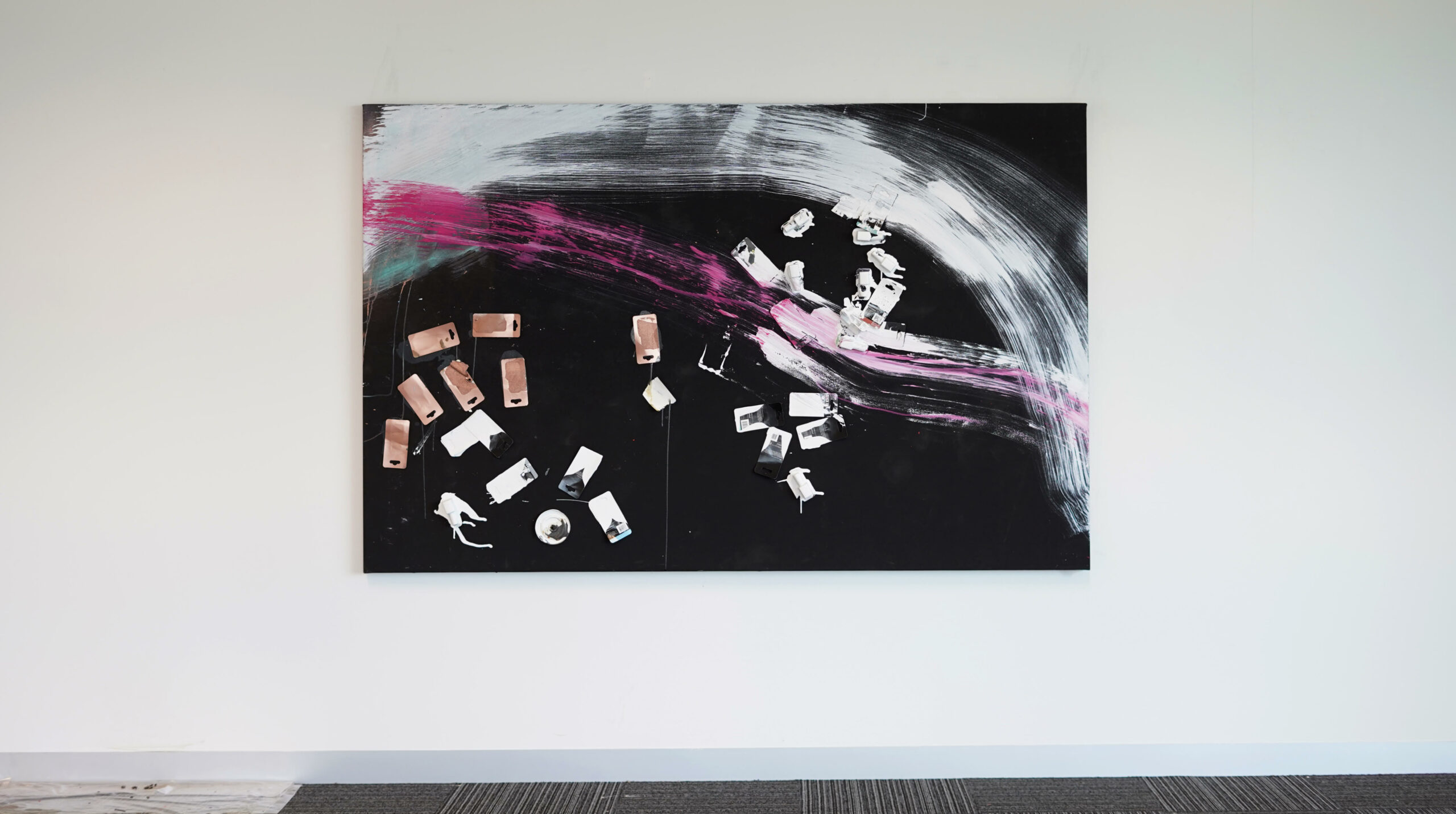
C: So what is the story behind the exhibition title?
H: We had this idea at our weekly Peppered Lemon symposium to call the show ‘We Broke Up’ because Ed was obsessed with coming up with thumbnails and copy for hypothetical youtube videos. We actually did almost break up in the process of making the show, spending so much time in the car together, getting into fights and threatening to crash the car and murder suiciding us both.
A: We had a joint dream through scissoring… The dream was about starting an amazing gallery in Pakenham.
H: Yeah so we decided to change the name of the show because the joint dream was much more positive.
C: I like that. One of my favourite lyrics comes from a Porno for Pyros song Freeway that goes “say you love me or I’ll kill us” and it’s about driving on the freeway. Sometimes I do my best arguing on the freeway. Something about the risk and dying with the person you love.
H: It’s the subconscious, it’s a place with no context so it’s like a dream.
C: How does it feel making art with your partner, does it exploit the intimacy of your relationship or the meditation of the studio?
A: It makes me feel afraid. But it feels like an art show. I think art is real so I'm always afraid before a show because it's personal to me and it’s my life. The studio thing I don't care about since it's kind of an anonymous space unless you know me personally. Hana is my muse, I love spending time in the studio with her, she inspires my paintings.
H: I’m scared and I want to die because sometimes I feel like nobody gets me except I know God will always show me my path.
C: That reminds me of a Brechtian quote you (Hana) used to refer to often like an exhibition rubric, ‘the second god to audience: next I am going to do a painting’, what is your relationship to spirit or author?
H: I think you’re referencing a work of mine from 2017 or my Meow show in 2021, and yes you’re right the title does refer to the Brecht quote. I like Brecht and plays in general… I kind of think I approach painting the same as film, like how a camera frames a set, a painting is all set in the frame of the canvas… It's like a meditation within the canvas. That boundary also designates the work’s convenience. As in it’s easier to ship, sell, conserve. I like that. I like painting. And I like that painting holds a certain prestige and autonomy in a gallery, it can’t be walked on, turned on or activated.
C: Is the artists studio a strip club?
H: Mmm no.
A: sigh
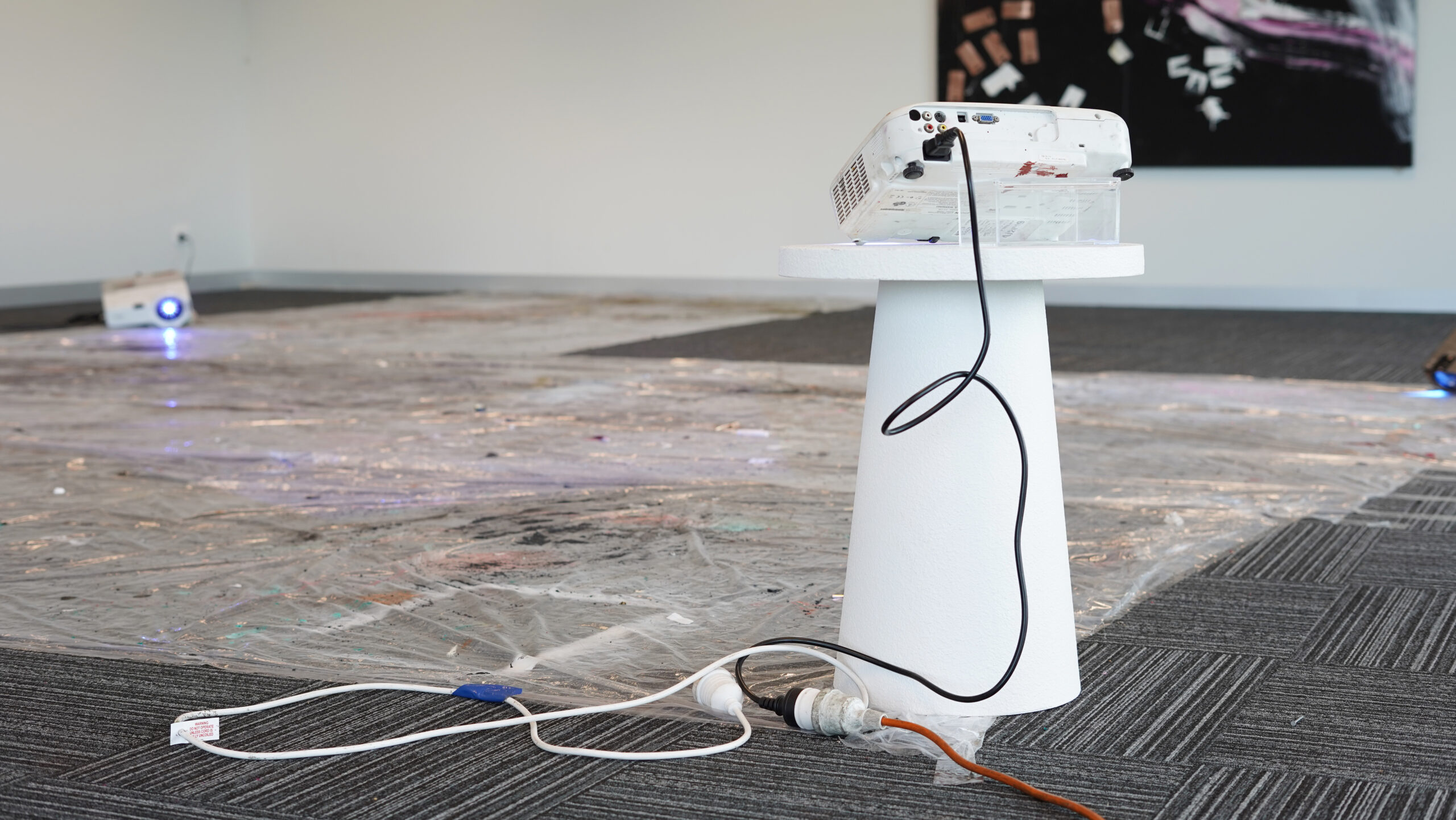
C: Do you think revealing or leaving the interior of your studio could be seen as performance art? I’m thinking of Nauman’s square dance, or his recent studio videos. Something about displaying your studio to the world feels finite, like the ending of an era, like the digital renditions of Francis Bacon's studio in his museum retrospectives.
H: Umm yeah I see it as personal but I don’t know if it really involves the body so much as performance usually does. It feels way more self conscious than performance. There is like an element of exhibitionism to showing work in your own studio.
A: No.
H: I redact the word exhibitionism, I mean vulnerability. I think all the greatest artworks for me hold something that is potently emotional. And there’s this person I can totally fall in love with who inspires you and makes you feel like you’re not so crazy for feeling how you feel.
C: I think performance relies on some effort of vulnerability. But I wouldn’t say this is a vulnerable show, it still feels controlled or dynamic. I wouldn’t have presumed this ensemble was stripped from a studio unless I were informed of the fact.
A: The Nauman work, square dance. It's like a painting stripped down. There’s the frame and then the body makes the shapes. All the possible shapes.. It reminds me of the feeling of looking at a blank canvas. I’d never do performance art, I’m too shy and I hate people looking at me. Maybe I perform painting, but I don’t see my work as being related to performance art. Hana’s work I see even less. I think if you can’t tell it’s a studio then the performance thing doesn’t matter. It’s not my studio anymore. It’s like making paintings in a gallery, not really a performance but you just have to make them somewhere. I like art that uses what’s around. It feels more real to me. There’s already a shape on the floor there, go with it .. I don’t know. I like to make studio floor paintings. Same approach… framing accidents, scatter art, Institutional critique, performing painting. It’s all visual language to use. I think the performance is already inherit in the painting. It's a trash painting but it’s not dirty.
C: It’s still quite clean, polished even, would you say it’s in the ‘style of’ a trash painting?
A: Using the language of that style, a bit.
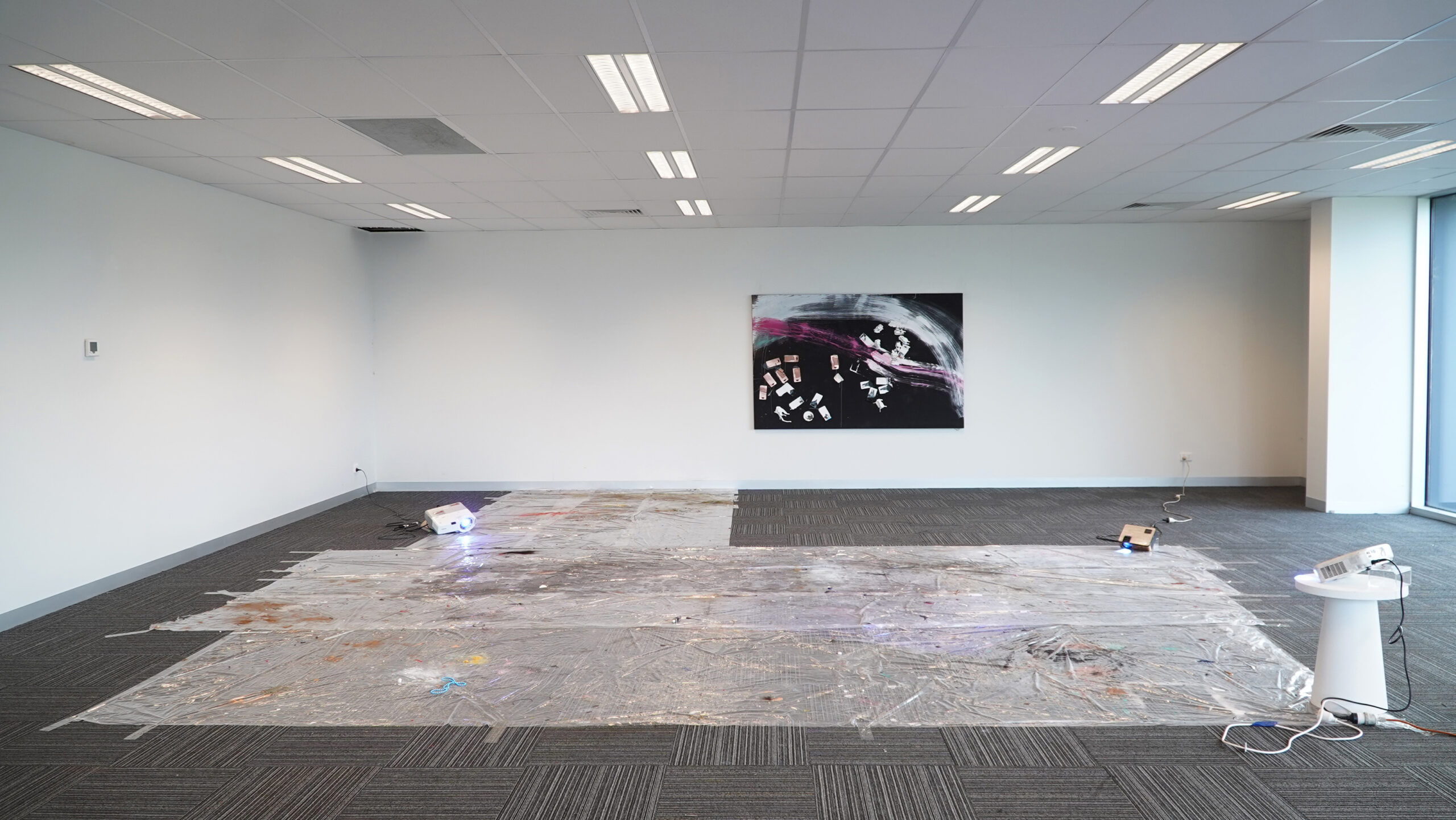
C: What is the difference between a studio floor and a studio wall or shelf?
A: I've never had a set up good enough to not have a floor studio. At Meow I had a floor studio but I was always afraid of the mice going on me. So even though I had a floor studio, I was always standing and crouching. Everything was always spilling and getting knocked over. I was always falling onto the painting.
H: Both the works come from the same place, as in they come from the floor but they’re just different angles.
A: Floor is like you're in the work, there’s this loss of perspective. You can't step back and look at what you've done like you can on the wall.
H: That’s kind of what making the show was like.
C: Like stimming? I can imagine you crouched over with your hair in your face playing with the crumbs and hairclips.
H: The floor is, it’s like a print or something, you know those Isa Genzken works that are rubbings of Gerhard Richter’s floor, it was kind of inspired by that, but more like a stage. There were different iterations, the process of making the floor work was basically taking away, cleaning up the studio until it was left with just the plastic sheets which protect the carpet and all the paint and pigment spilt.
A: And then the painting was also made on top of the plastic.
C: So where do the projectors come in? They’re like production lights thrown on top of an honest document. I guess it reads like a galaxy with the glitter.
A: It’s like how painters use projectors.
C: Maybe that’s what I’m understanding as the layer of narrativisation that enters through the process of elimination. You could have kept going until you emptied the room, like the impossible task of ‘when is a painting finished?’
H: Thats why the illusion comes in, you present the illusion of not being invisible.
C: Like exhibiting an empty room. People do that, they’re crazy.
A: No, what I mean is reaching the point of not even having an exhibition.
C: Right, I wonder what the difference is between an expulsion of the self and the elimination of the ‘I’. Like the Badiou thing, but I don’t know if running away to farmland equates to that – the discipline of isolation still feels like mandatory step within practice. Maybe it’s just a cowboy thing, it’s like a Wim Wenders movie.
H: It’s like Paris Texas, because it’s also kind of magic.
C: I’m not a magical person, what’s the deal with the magic? Is subtraction a method of dissent?
H: It looks like magic, you know like smoke and mirrors, there’s lights and illusion.
A: There’s like animals around here and stuff. There’s these giant hares that hop around the field at night.
H: The subtraction isn’t supposed to be aggressive, maybe like passive aggressive.
C: Mysticism is wild to me, I can’t artistically chart into that territory. Once you know it’s just debris, it’s just debris and there’s no need to antagonise that.
H: It’s like i’m invisible.
C: Do you want to be invisible?
H: Sometimes.
C: This might be too on the nose, but the distance sort of alludes to the vanishing point, the end of the horizon line.
H: The show just looks like ‘magician’.
A: If the projectors weren't there, would it even look like art?
C: I mean the process of elimination would hold the same, the room would carry the same meaning through methodology had you emptied the entire studio of its belongings.
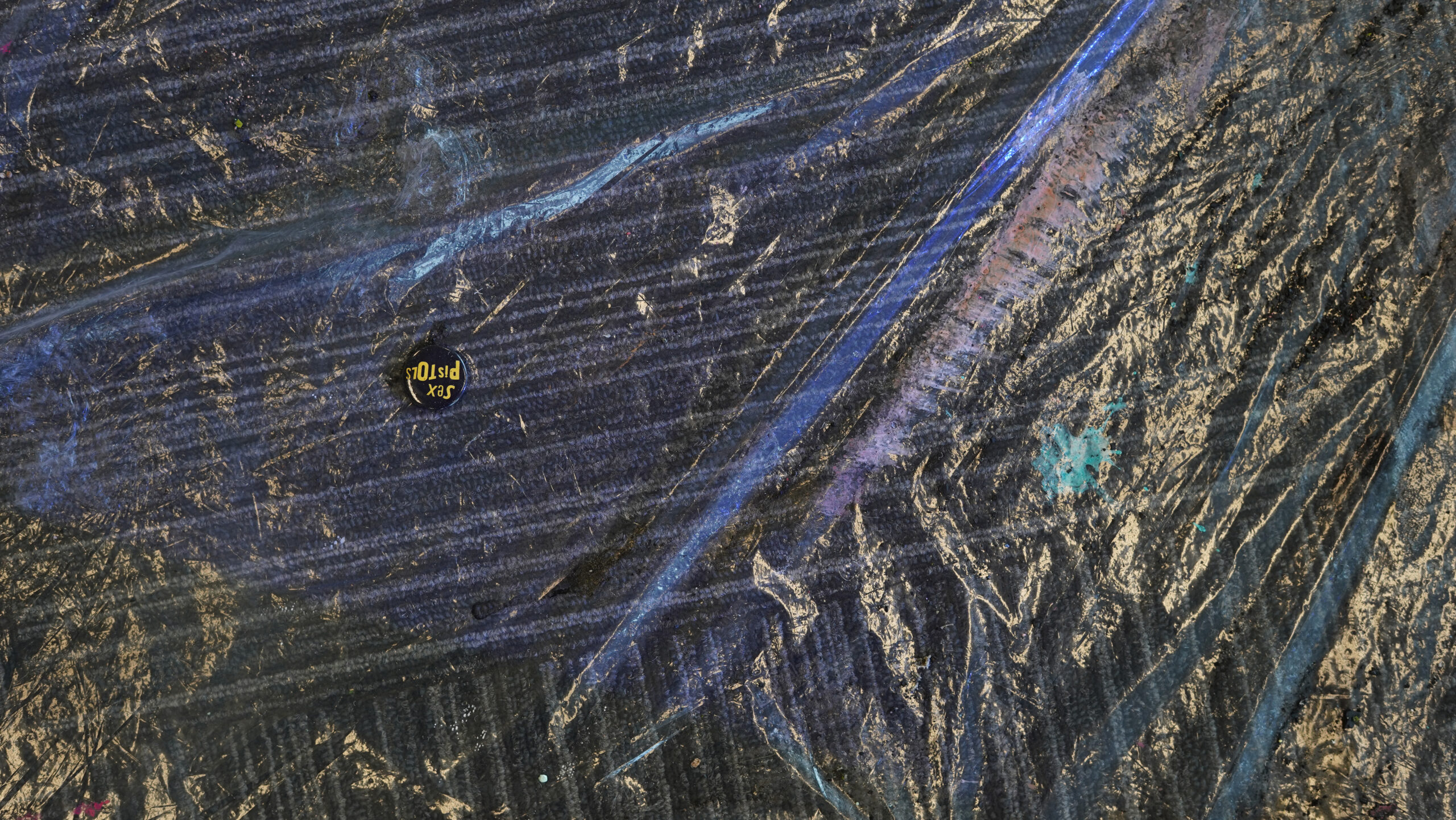
C: Do you like the Sex Pistols?
H: Yeah I like the Sex Pistols, sort of, those badges are from Brandy Melville.
C: I need to buy underwear from there. What does pop music mean to you?
A: I'm drinking a soy latte, I get a double shoté. It goes right through my body, and you know I'm satisfied.
H: Like a f**8999 Dream on Ritalin.
C: What is your most played song?
H: Chopin Nocturnes in B flat.
A: Ice spice.
C: You’re both painters, does the control of painting come naturally as a technical or mechanical reflex? Does it operate the same as objects or trash assemblage?
H: I don’t consider myself a painter. Painting makes me uncomfortable and doesn’t come naturally at all. I admire painters though.
A: What is the difference between a painting and an assemblage?
H: Painting is on canvas on stretchers.
A: You can put a piece of gum on the wall and call it a painting. You can assemble things on a canvas. Maybe if you stick it down… Ugh I'm boring myself with this.
H: I would never consider a piece of gum unstretched on the wall a painting.
C: What do you anticipate for the impending future?
A: Karens, vespas, comedy, blue light, long coats, short hair, track pant/ capri girl dichotomy, art brut, magic, newphoria the word, korea, pinot noir, comedy.
H: More of whatever this is.
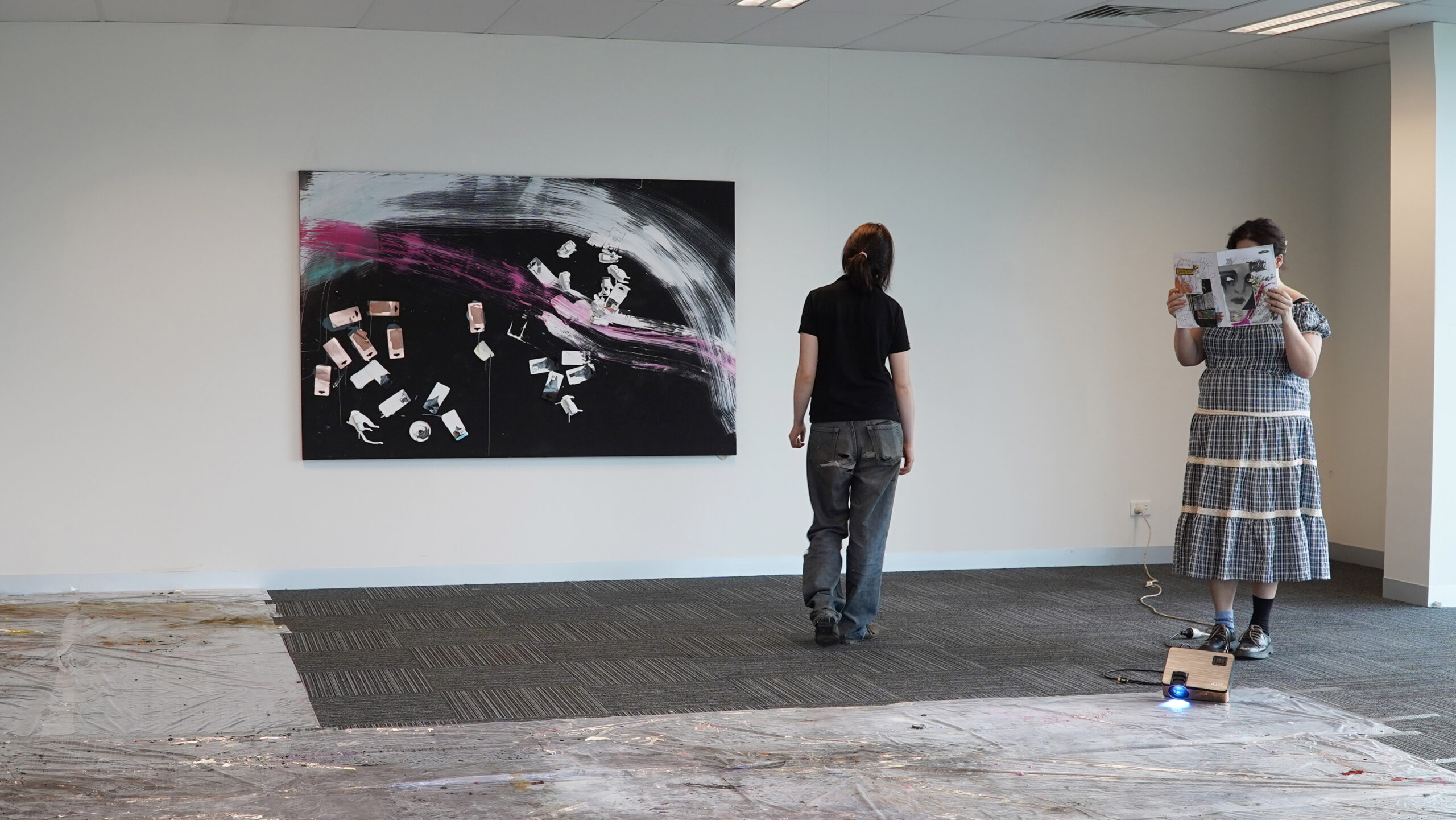
Carmen-Sibha Keiso is an artist, writer and curator working in performance, video, and text. Keiso is director and facilitator of ‘Read the Room’ an expanded literary practice space that hosts experimental writing workshops, lectures, readings and exhibitions in Melbourne.
un Projects’ Editor-in-Residence Program is supported by the City of Yarra, Creative Victoria and City of Melbourne
Editor: Carmen-Sibha Keiso. All images courtesy the artists and author.
